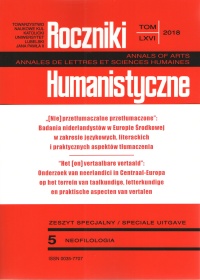The competention profile of the legal translator and the method of legal comparison as an instrument for the translation of ‘untranslatable’ legal terminology
Abstract
We can define the legal comparison in two ways. From the perspective of the description, in which it can be used to explain how two legal systems or certain institutions operate within a particular legal system, or from an application as an instrument to achieve other purposes within the legal domain. The use of the methods of comparative law comparison for legal translators lies precisely in this applied area.
In this article, comparative law is not approached in itself, but purely as an educational tool and exercise in legal translation. We will examine the methodology of legal comparison and apply it to concrete problematic, or ‘untranslatable,’ legal terms. Examples are references to legal concepts, institutions or procedures that only occur in the source language legal system but not in the target language legal system. One of the most important principles of legal comparison is that if we want to compare two objects or concepts, we must assume that they are comparable, at least in relation to one aspect (tertium comparationis). Unlike lawyers who use the method of legal comparison directly, legal translators cannot content themselves with this principle. They must find a translation for a particular legal entity, document or procedure, even if it has no equivalent in the target language legal system. The starting point for illustrating certain solutions to such translation problems is that legal translators should act as mediators between different legal cultures with the task of effectively transferring legal information, regardless of different legal traditions and legal languages.
References
Bloemen, Henri. 2004. ‘Onvertaalbaarheid: tussen theorie en praktijk van het vertalen.’ In Ton Naaikens (ed.). Denken over vertalen. Tekstboek over vertaalwetenschap, 29–219. Nijmegen: Vantilt.
Broeck, Raymond van den (ed.). 1994. Bouwen aan Babel. Zes opstellen over onvertaalbaarheid. Antwerpen & Harmelen: Fantom.
Gentile, Paola. 2017. ‘Het zelfbeeld van sociaal tolken, een miskend en onderschat beroep.’ Internationale Neerlandistiek 55 (1): 1–22.
Gonzáles, Julia, & Robert Wagenaar (eds.). 2003. Tuning Educational Structures in Europe. Final Report. Pilot Project — Phase 1. Bilbao: University of Deusto.
Hertog, Erik, & Jan van Gucht. 2006. Status Quaestionis. Questionnaire on the Provision of Legal Interpreting and Translation in the EU. Antwerpen: AGIS Programme-European Commission.
Kelly, Dorothy. 2005. A Handbook for Translator Trainers: A Guide to Reflective Practice. Manchester: St. Jerome Publishing.
Luther, Martin. 1530. ‘Zendbrief over het vertalen (Sendbrief vom Dolmetschen).’ In Ton Naaijkens (ed.). Denken over vertalen, tekstboek vertaalwetenschap, 15–25. Nijmegen: Vantilt 2004.
Prieto Ramos, Fernando. 2011. ‘Developing Legal Translation Competence: An Integrative Process-Oriented Approach.’ Comparative Legilinguistics — International Journal for Legal Communication 5: 7–21.
Schleiermacher, Friedrich. 1813. ‘Over de verschillende methoden van vertalen (Ueber die verschiedenen Methoden des Uebersezens).’ In Ton Naaijkens (ed.). Denken over vertalen. Tekstboek over vertaalwetenschap, 41–55. Nijmegen: Vantilt 2004.
Simonnaes, Ingrid. 2013. ‘Legal Translation and “Traditional” Comparative Law — Similarities and Differences.’ Linguistica Antverpiensia 12: 147–160.
Soriano-Barabino, Guadalupe. 2016. Comparative Law for Legal Translators. Oxford: Peter Lang.
Vandeweghe, Willy. 2005. Duoteksten: inleiding tot vertaling en vertaalstudie. Gent: Academia Press.
Wagner, Emma, Svend Bech, & Jesús Martínez. 2002. Translating for the European Union Institutions. Amsterdam & Philadelphia: John Benjamins Publishing Company.
Copyright (c) 2018 Roczniki Humanistyczne

This work is licensed under a Creative Commons Attribution-NonCommercial-NoDerivatives 4.0 International License.





